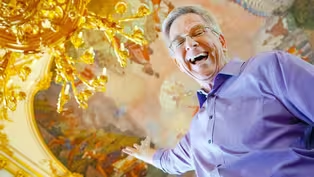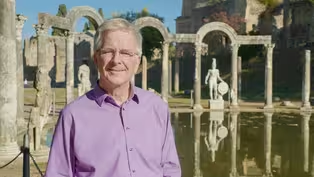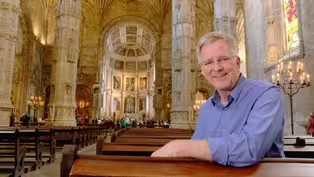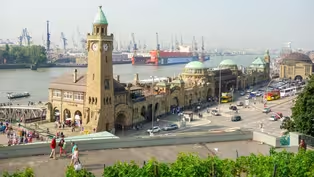Rick Steves' Europe
Rick Steves’ Europe: Art of the Impressionists and Beyond
Season 12 Episode 1211 | 28m 26sVideo has Closed Captions
Shimmering Impressionist canvases by Monet and Renoir, plus Van Gogh, Gauguin and more.
The late-1800s saw old notions of beauty challenged by revolutionary artists. We enjoy pioneering Impressionist works—Monet’s lilies, Renoir’s ladies, Degas’ snapshots and Rodin’s statues—that capture the joie de vivre of the age. We trace the tempestuous travels of Van Gogh through his incomparable art. And we finish in Spain, with wild and crazy buildings that herald the dawn of a new century.
Problems playing video? | Closed Captioning Feedback
Problems playing video? | Closed Captioning Feedback
Distributed nationally by American Public Television
Rick Steves' Europe
Rick Steves’ Europe: Art of the Impressionists and Beyond
Season 12 Episode 1211 | 28m 26sVideo has Closed Captions
The late-1800s saw old notions of beauty challenged by revolutionary artists. We enjoy pioneering Impressionist works—Monet’s lilies, Renoir’s ladies, Degas’ snapshots and Rodin’s statues—that capture the joie de vivre of the age. We trace the tempestuous travels of Van Gogh through his incomparable art. And we finish in Spain, with wild and crazy buildings that herald the dawn of a new century.
Problems playing video? | Closed Captioning Feedback
How to Watch Rick Steves' Europe
Rick Steves' Europe is available to stream on pbs.org and the free PBS App, available on iPhone, Apple TV, Android TV, Android smartphones, Amazon Fire TV, Amazon Fire Tablet, Roku, Samsung Smart TV, and Vizio.
Providing Support for PBS.org
Learn Moreabout PBS online sponsorshipMore from This Collection
Rick Steves’ Europe: Baroque Art
Video has Closed Captions
We marvel at Baroque’s over-the-top churches, palaces, bubbly fountains, and theatric art. (28m 22s)
Rick Steves’ Europe: Art of the Roman Empire
Video has Closed Captions
The grand cities of ancient Rome’s vast empire and majestic churches of its fall. (28m 23s)
Rick Steves’ Europe: Art of the Renaissance Beyond Florence
Video has Closed Captions
From Portugal to Germany, booming economies and new technologies produce exquisite art. (28m 42s)
Rick Steves’ Europe: Art of the Florentine Renaissance
Video has Closed Captions
Florence’s bold “rebirth” is powered by the genius of Leonardo, Rafael, and Michelangelo. (28m 3s)
Rick Steves’ Europe: Art of Prehistoric Europe
Video has Closed Captions
We marvel at Stone Age cave paintings, mighty megaliths, and mysterious goddesses. (28m 4s)
Germany's Hamburg and the Luther Trail
Video has Closed Captions
Hamburg, Germany’s mighty port city has risen from the ashes of World War II (26m 47s)
Providing Support for PBS.org
Learn Moreabout PBS online sponsorship- Hey, I'm Rick Steves back with more of the best of Europe.
This time rather than a particular place, we're going thematic and traveling wherever that theme takes us.
In this episode, it's the Impressionists and those who follow from Monet to van Gogh to Alen.
Thanks for joining us.
(lighthearted music) Europe in the late 1800s experienced the biggest revolution in art since the Renaissance.
The Impressionists, with their passion for capturing shimmering light on canvas, turned the art world on its head.
With the next generation, the Post-Impressionists, the art world just kept changing, as these rebels explored new frontiers in artistic expression.
We'll meet a rat pack of non-conformists armed with easels and brushes and determined to change the world of art.
(lighthearted music) Monet with his fellow Impressionists, Rodin, who sculpted Impressionism into bronze and stone, and the Post-Impressionist taking art in a tangle of innovative directions.
From Luca with his sinuous Art Nouveau, to Seurat with his dots, Cezanne with his slabs, Gauguin with his exotic primitivism, and van Gogh, who, with his swirling brushstrokes, invigorated all he painted.
In the late 19th century, the art world was dominated by the prestigious French art school called The Academie.
But some independent artists struggled to be free from its stuffy dictates.
The result, a period with both conservative and revolutionary art at the same time.
(gentle music) Mainstream 19th century artists painted idealized beauty, while with plenty of nudes, this was conservative art popular throughout the 1800s because it was simply beautiful.
Kavanagh's "Birth of Venus" was the quintessence of beauty.
This love queen, reclined seductively, just born from the foam of a wave.
At the time, sex was considered dirty and could be exalted only in a more pure and divine form.
Such idealized beauty sold well.
It was made to order for well-off customers who were afraid of change.
But outside the conservative Academie, a new breed of artists was painting the real life of real people.
Called the Realists, they captured honest snapshots of everyday life, from no-nonsense portraits, to peasant spinners of yarn, to gleaners bending low to scavenge what they can from an already harvested field.
This unvarnished realism proved shocking.
Instead of painting more dreamy goddesses, Gustave Courbet gave a gritty behind-the-scenes look at his studio.
His model, not a goddess, but a real woman, takes a break to watch Courbet at work.
And the little boy admires the brave artist for bucking conformity.
Edouard Manet took realism to another level.
He posed this prostitute like a classic goddess.
But instead of golden skin and a radiant face, he made her shockingly ordinary.
Her hand is a clamp.
Her stare, calculating.
Ignoring the flowers her servant brings from her last customer, she looks out as if to say, "Next."
Manet innovated, he placed this woman alongside men in business suits, brazenly accentuating her nudity.
Rather than the polished brushwork of The Academie, he experimented with thick paint, sharp outlines, and odd perspective, further perplexing the critics.
When Manet had his work rejected in 1867, he put on his own show, thumbing his nose at the establishment.
Manet's boldness attracted a younger generation of artists.
They admired him for his everyday subjects, experimental techniques, and his artistic integrity.
Soon they'd strike out on their own.
Let the Impressionist revolution begin.
These artists were known as the Impressionists.
Freed from the stifling constraints of The Academie and inspired by the realists, they took their easels outdoors.
Their philosophy, like a Declaration of Independence, it was out of the studio and into nature.
The Impressionists painted the French countryside, but the true subject wasn't so much the farms, rivers and forests.
(gentle music) It was all about the light.
They even studied which pigments would reproduce reflected light most accurately.
And when the light was just right, they painted furiously to catch the scene before it was gone.
The way the light reflected off the passing clouds, the waving grass, the billowing dress.
The father of Impressionism was Claude Monet.
The son of a grocer with little formal education, he dedicated his life to discovering new ways of seeing things.
With this quick impression of a harbor at sunrise, Monet helped give the movement its name.
The real subject, the impression of the light reflected on the water, rendered in a few squiggly lines or broad strokes of paint.
Impressionists used an innovative technique.
They applied bright colors in thick dabs side by side on the canvas and let them mix as they traveled to your eye.
Up close, it's a mess, but move back and voila.
Since the colors never completely resolve, they continued to vibrate in the mind, giving Impressionist paintings their shimmering vitality.
With Impressionism, the physical object in the painting was now just the rack upon which the light, shadow and color would hang, and that's what the artist work to capture.
(lighthearted music) Monet would paint the same subject at different times of day and in different weather to capture the different light.
A cathedral, for example, in morning sun, full sun, and gray weather.
The same building becomes a montage of subjects as it dissolves into pure light and color.
Monet's friend, Renoir, also pioneered the Impressionist style.
With his working class background, Renoir loved to paint everyday Parisians dressed in their Sunday best, gathering at outdoor cafes to eat, drink and dance.
Renoir's bright colors caught the glowing afternoon sunlight, filtering through the leaves, dabbling the dancers with darts of light like a 19th century disco ball.
As if snapping a photo with a slow shutter speed, he created a waltzing blur of joy.
With soft focus and broad brushstrokes, Renoir painted easygoing scenes of everyday people, especially women.
His nudes were voluptuous.
And he caught the innocent joy of middle class life.
As Renoir himself said of his always happy paintings, "There are enough ugly things in life."
Each of the Impressionists developed their own distinctive style, Pissarro with his grainy earthiness, Sisley with his cloudy landscapes, and Edgar Degas with his ballerinas.
(dramatic music) With his knack for catching subjects at an unguarded moment, Degas showed dancers rehearsing hot, tired, and bored.
But when the lights came on, Degas captured all the onstage glitter, the joie de vivre of France's beautiful age, the Belle Epoque.
(gentle music) From his mansion in Paris, Auguste Rodin brought Impressionism to sculpting.
His rough surfaces rippling with frosting like texture were like thick brush strokes on a canvas, capturing the effect of reflected light on stone or bronze.
Rodin made ordinary people seem noble, and their nudity makes them universal.
Like a modern Michelangelo, he sculpted human figures with powerful insight, revealing, through the body, their deepest emotions.
Rodin's historic mansion, now a museum, shows off the full range of the artist's work.
His early pieces reflected the Belle Epoque style of the late 19th century, noble busts of bourgeois citizens and pretty portraits of their daughters.
But with his working class roots, Rodin forged a more down to earth raw and individual style that shocked the art establishment.
Look at the intensity of this symbol of France as she screams, "Liberte, egalité, fraternite."
with his groundbreaking bronze man Rodin came into his own and was recognized as an artistic force.
From this point on, he left convention behind and blazed his own artistic trail.
Here, his "Hand of God" shapes Adam and Eve from the mud of the earth to which they will return.
Unlike Michelangelo who selected a piece of marble and then carved a single work of art, Rodin created models which could then be reproduced and sold as authorized versions.
In "The Kiss," a woman twines around her solid man seemingly lost in a forever embrace.
While the stories from a legend and their lips never quite meet, the statue was controversial.
(gentle music) That's because Rodin portrayed the woman as being equally passionate as the man in the love making.
Though provocative, the statue proved to be a big hit with the public.
Rodin's garden was a leafy impressionist scene come to life.
Even today, visitors find it a place for peaceful meditation, a century after the artist last planted a statue here.
Rodin's most famous legacy is his "Thinker," leaning forward, tense, and compact, every muscle working toward producing that one great thought.
It captured the intensity of Rodin's own creative process.
Said Rodin, "It is a statue of myself."
Impressionism reached its culmination with the same man who started it, Claude Monet.
Late in life, Monet moved to this garden estate.
The colorful gardens were like his brush strokes, a bit slap dash, but part of a carefully composed mosaic.
Monet made a pond and filled it with water lilies.
(gentle music) He painted the water lilies in this ensemble of canvases, all focusing on the ever changing light from the pre-dawn darkness, to clear morning light, to afternoon lavender, to golden sunset.
He'd start by laying down thick, big brush strokes of a single color, horizontal and vertical, to create a dense mesh of foliage.
Then add more color for the dramatic highlights until he got a dense paste of piled up paint.
Up close, it's messy.
But back up, and the colors resolve into a luminous scene.
Just pure reflected color.
The true subject is not really the lilies, but the changing reflections on the pond where lilies mingle with the clouds and trees.
Monet cropped his scenes ever closer until there was no shoreline, no horizon, no sense of what's up or down, until you're completely immersed.
In his final paintings, the great Impressionist dissolved the physical subject more and more into purely abstract patterns of colorful paint anticipating the future of art.
The Impressionists were like a tribe.
They spoke the same artistic language, but after that, more than ever, artists went in different directions creating art that was uniquely their own.
And those artists were the Post-Impressionists.
George Seurat took the Impressionist technique to its logical conclusion, reducing the brushstroke to a brush dot.
(gentle music) This was pointalism.
All the dots would blend in the eye like a shimmering mosaic of reflected light.
Paul Cezanne built his scenes not with dots but with thick slabs.
His subjects were simple and familiar, objects reduced to their basic geometrical forms: spherical apples, rectangular houses, and people posed in triangles.
By simplifying reality into fundamental shapes, Cezanne inspired future artists to see ordinary things in a new way.
Paul Gauguin sailed to exotic Tahiti where he painted the native people.
What may seem primitive and simple is actually intentional.
Flat scenes with no shading, black outlines filled in with bright colors.
The space decks up rather than recedes when he uses the same colors in the foreground and the background.
His women, so different from the establishment Venuses of The Academie back in Paris, lounge innocently giving uptight Europeans a glimpse of a pacific Garden of Eden.
And among the boldest of these Post-Impressionists was Vincent van Gogh.
For van Gogh, his life and art were intertwined.
A humble pastor's son from a small Dutch town, he spent time helping poor coal miners in search of his calling.
He gave farm laborers the same dignity usually afforded aristocrats.
Through his art, he portrayed a vibrant world he felt so intensely.
He moved to Paris, and the City of Light opened up a whole new world of color.
Vincent hobnobbed with the Impressionists.
He studied their bright colors, rough brush work, and everyday scenes.
(gentle music) He painted shimmering reflections like Monet, cafe snapshots like Degas, still life's like Cezanne, and self portraits like nobody else.
He set out for the south of France, energized by the sun-drenched colors and the breathtaking vistas.
In just two years, Vincent produced an explosion of canvases: sunshine, rolling hills, the patchwork farms.
Working in the open air, he feverishly painted the landscape, the simple workers and the starry, starry nights.
His unique style, thicker paint, brighter colors, and swirling brush work made everything he painted pulse with life.
Vincent's ecstasy alternated with dark times.
He painted the loneliness of his own room.
He drank too much and suffered bouts of depression.
He was admitted to a local hospital where he found peace painting calm scenes of nature.
But it seems he also wrestled with his inner demons, capturing spiritual scenes with surreal colors, twisted forms, and dark outlines.
In one of his last works, the canvas is a wall of thick paint with roads leading nowhere and ominous crows taking flight.
Overwhelmed with life, Vincent walked into a field like this one and shot himself.
With his paintings, van Gogh, though unappreciated in his own time, inspired his fellow artists to seek a new kind of beauty.
The year before van Gogh died in 1889, Paris erected its Eiffel Tower.
The centerpiece of a World's Fair, it was a symbol of Europe's progress, celebrating how technology could merge with art to be both functional and beautiful.
The mighty tower proclaimed the can-do spirit of the industrial age.
(regal music) Its no-nonsense iron beams were not plastered over with older styles like neogothic or neoclassical, but proudly displayed.
With its graceful curves and unabashed embrace of technology, the tower helped inspire a new style of art, Art Nouveau.
This new art turned modern technology, iron glass ceramic tiles, into beauty.
Inspired by the curves of plants, artists made columns and ribs feel like a forest.
They decorated humdrum metro entrances with artistic iron work, employed a playful blend of organic swoops and vertical lines.
Facades are colorful.
And interiors glow with stained glass.
Art Nouveau was an epoch of beauty.
It celebrated creativity and the notion that art, design, fine living, it all flowed together.
(lighthearted music) In their homes, the wealthy decorated with leafy designs.
They added curves and beautiful inlays to furniture, and even added a graceful touch to the latest home technology, turning even the most practical everyday objects into works of art.
The sumptuous beauty of Art Nouveau was wearable as well.
In Paris, a struggling Czech immigrant named Alphonse Mucha created a theatrical poster with a uniquely sinuous touch.
It was an overnight sensation, and Mucha had set a template for Art Nouveau.
Willowy maidens with elegant gowns and flowing hair, immersed in a background of flowery pastel designs, visions of the good life and pure beauty.
The flowery style blossomed all over Europe.
While in France it was called Art Nouveau.
In Germany and Austria, it was Jugendstil, young style.
And in Barcelona it was modernisma.
(gentle music) Upscale neighborhoods shimmered with colorful, leafy and organic shapes.
On this street, several mansions jostled to outdo each other in creativity.
Galloping gables, molded concrete, colorful ceramic tiles and shards of glass.
Perhaps the most innovative mansion of all with its roller coaster curves and melting ice cream eaves was by hometown boy Antoni Gaudi.
With his Casa Mila, the organic sensibilities of motorist architecture flowed into practical everyday living.
This apartment for a wealthy businessman shows how the affluence of the industrial age was enjoyed on a personal level, at least by the upper class.
Now, an apartment could be a small palace.
Barcelona's Park Guell shows a more playful side of Gaudi's architectural genius.
(jovial music) While today, the grand stairway and its welcoming lizard feels like a park for fun seekers, Gaudi intended this 30-acre garden to be a housing development for 60 residents, a kind of gated community.
Fanciful viaducts compliment the natural landscape.
As a high-end housing development, the project flopped.
But a century later, as a park, it's a huge success.
As you wander, imagine that the community succeeded and you were one of its lucky residents.
Here at the hall of the a hundred columns, the intended produce market, you'd enjoy the fanciful columns in decor while you did a little shopping.
Heading home, you'd stroll through what feels like the barrel of a cresting wave, another nature-inspired Gaudi fantasy.
And on such a beautiful day, you'd sit a spell on Gaudi's organic benches to enjoy a grand view of this grand city.
Gaudi's grandest work is his church of the Sagrada Familia, or holy family.
(gentle music) He worked on this mega structure for over 40 years and left it to later architects to finish.
With its soaring honeycomb towers, it radiates like a spiritual lighthouse.
The stone ripples and the surface crawls with life, animals, birds, trees, and people.
Gaudi combined Christian symbolism, images from nature and the playful flare of modernisma.
Like a concrete forest, the church seems to grow organically reaching to heaven.
The soaring nave features columns that blossom with life.
Wandering here, you can almost feel the futuristic spirit of the entire late 19th century age, the dappled light so beloved by the Impressionists, the bold creativity of the Post-Impressionists, the sinuous curves of Art Nouveau, all of which Gaudi captured and set in stone on an epic scale.
Europe offers a lifetime of artistic treasures, and the more you understand its art, the more you'll appreciate the society that created it.
I hope you've enjoyed our look at the Impressionists and Post-Impressionists who primed the world for what would follow, the wild and crazy art of the 20th century.
I'm Rick Steves.
Until next time, keep on traveling.
Hey, I'm Rick Steves.
Remember, this station is unique on the dial.
It's public and made possible with your support.
Public television is quality media.
It sees us not as shoppers or eyeballs on some ratings chart, but as neighbors and fellow citizens.
Considering how influential media is in our community these days, the value of this channel has never been greater.
I'm haunted by a belief that there are powerful forces in our society that would find it convenient, more profitable, frankly, if we were all just disengaged, dumbed down.
Commercial stations seem to do just that.
But here in public television, the programming is positive, it's uplifting, and it expands our horizons.
Public media inspires us to be not afraid, but to be confident, not disillusioned but engaged, not discouraged but encouraged.
And it only happens with support from viewers like you.
Pledge your support to this station and you also get great benefits, including Passport, which gives you even more access to stream even more shows right here.
Consider the value that the programming you enjoy adds to your life, and then scan or go online and make your donation now.
(bright music) - [Announcer] Invest in your local PBS station by becoming an $8 monthly sustainer, or make a $96 annual contribution right now, and we'll say thanks with a wonderful collection of gifts.
You'll receive Rick Steve's book, "For the Love of Europe," which shares his favorite memories from decades of travel in 100 essays.
It's 400 pages of fun and inspirational travel stories.
On top of that, you'll receive a copy of "Europe Through the Back Door."
This book is packed with practical tips from chapters on packing light and planning a smart itinerary, to eating your way through Europe and finding great hotels.
We'll also send you this map Europe, which is perfect for pre-trip planning and using while you're on the vacation of your dreams.
Plus, you'll receive Rick Steve's newsletter, which is packed full of travel tips about European destinations.
And don't forget, with your qualifying contribution, you'll be able to enjoy a terrific member benefit, PBS Passport, which lets you watch every one of Rick's shows that's available on the PBS app.
With PBS Passport, you'll also be able to stream a treasure trove of your favorite dramas, history, arts, music, and more.
So don't wait.
Go to pbs.org/rick to give now.
Thank you.
- As you can see, it's easy to donate to support public television, whether you're watching the station on the air or streaming shows like this right here.
Please take a moment to make your donation.
Doing so, you'll support your local station and the great programming it brings your way.
And again, as a bonus, you'll enjoy great benefits including Passport.
Thanks a lot.
(bright music) (bricks pounding) (door slamming) (bright music)
Support for PBS provided by:
Distributed nationally by American Public Television




















